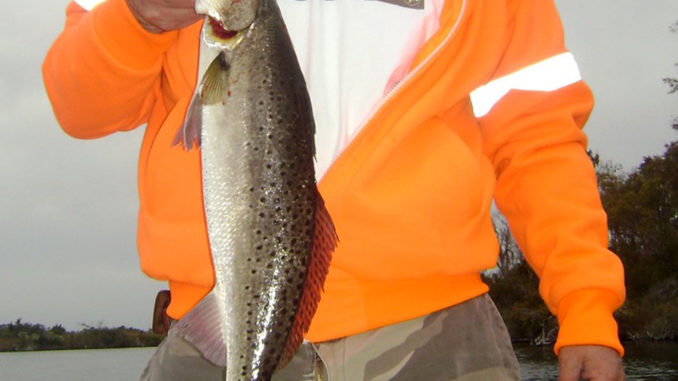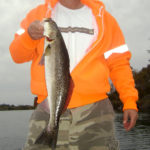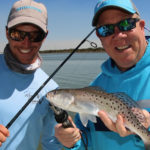
Specks will congregate on flats’ odd features
Ben Powers of Reel Time Charters in Charleston, S.C., directed the attention of the two fishermen on his boat to a place he expected to find speckled trout.
‘Take a look at that point to the right of us that extends out to the current,” he said. “Now, look at the point to the left of us that juts out just as far. You can see a line running between those two points with current on one side of that line and slack water on the other. Everything between that line and the bank is called a flat, and that flat is made up of edges. And speckled trout love edges.”
Powers loves fishing flats for trout as much as trout love edges; he said many anglers don’t realize just how many edges exist in a flat.
“The most obvious edge on this flat is that line of grass against the bank, and trout will certainly be on that edge,” he said. “But a lot of people don’t realize this line of current creates two different edges, and because it is out so far away from the bank, they just don’t think about fishing it.”
The two edges created by that line of current, he said, include the surface where the current meets slack water, and also a line underwater where the current carves out an edge that may be as small as a 6-inch difference in depth between the flat and the main channel.
“It is out far enough from the bank that it looks like no-man’s-land, but the trout are there in numbers,” he said.
And no matter how big or small a flat is, those are rarely the only edges present. Many flats have oyster beds that are at least partially exposed at low tide. The edges of those beds also attract sea trout, especially just as the incoming tide begins to cover them.
Once he establishes where the edges are on a flat, Powers said catching trout becomes a game of trial and error, presenting baits and lures to one edge, then another, until he locates the fish.
“This time of year, if you find a trout in a flat, you’re going to find more than one,” he said. “They will be in groups of various sizes, so if you catch one, give that area some extra attention and you should catch more.”
Jigheads with Z-Man soft plastics, various soft-plastic shrimp or live shrimp under a popping cork are good options for fishing flats. Popping corks can be especially great to fish along that current line, because you are fishing two edges at the same time. Powers suggests casting upcurrent, then letting the cork ride the current down, covering a lot of water with one cast.
After the cork has drifted a good distance, Powers advises anglers to work it back it by popping, reeling and pausing enough to let the bait settle, then doing it again.
And while many anglers pop their corks with an upward or a sideways motion of the arm and rod tip, he said a better way is with a downward, popping motion. This creates the popping sound, but it moves the cork a shorter distance, keeping the bait in the strike zone longer.
Daniel Lee Sbrocco of Jacksonville, N.C., who runs the Eastern Carolina Winter Trout Series, agrees that finding the edges on flats is a key to consistently catching trout. One of his favorite techniques is to float a Vudu Shrimp under a popping cork along the edge of an oyster bed as the incoming tide crashes on both sides of the bed, creating an edge of water where the two currents meet. This area of turmoil is a great ambush spot.
Sbrocco lets the current carry his popping cork toward that line, and just before it hits the line, he gives the cork a sharp pop. Often, that’s all it takes to entice a trout into biting. If he doesn’t get bit after making another one or two pops in the current, he reels in and tries again. This is a very productive technique, but it only lasts as long as it takes for the incoming tide to cover that oyster bed.
Sbrocco also likes to cast parallel to edges with an Egret Baits Wedgetail Eel on a ShredFyn spinner in deep holes at dead low tide. Sometimes he burns it back to the boat; other times he slowly reels it in. Both are effective until the incoming tide floods the flat.







Be the first to comment